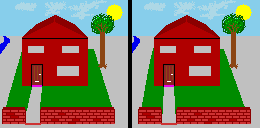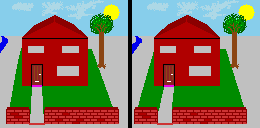
In a cross-eyed image, the view for the left eye is positioned on the right. The image is viewed by deliberately crossing one's eyes until the two images come together. It is difficult to explain how to do this, but one possible way is this. Hold a finger a short distance in front of your eyes and stare at it. In the background you should see two copies of the stereo pair, giving four views altogether. Move your finger away from you until you see the middle two of the four images come together. You should now see just three images in the background. Try to direct your attention slowly toward the middle image without moving your eyes, and it should gradually come into focus.

In a wide-eyed image, the view for the left eye is positioned on the left. The image is viewed by deliberately diverging one's eyes until the two images come together. To the newcomer this is usually a much more difficult technique to acquire, but most experienced viewers seem to find that it is easier and more relaxing to obtain a stable view of an image by this method. I do not know of an easy way to learn this viewing technique, but the way I learned was by printing out a SIRDS (that is, a single-image random-dot stereogram) on to a transparent sheet and looking through it at a distant object.